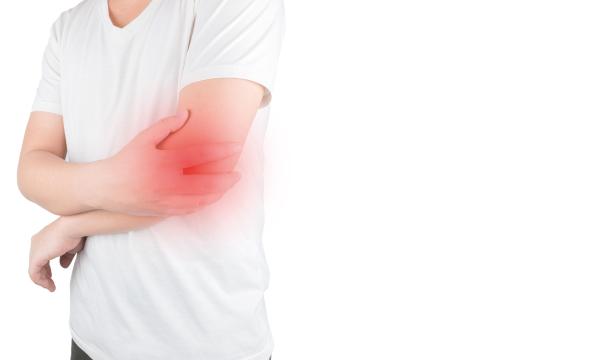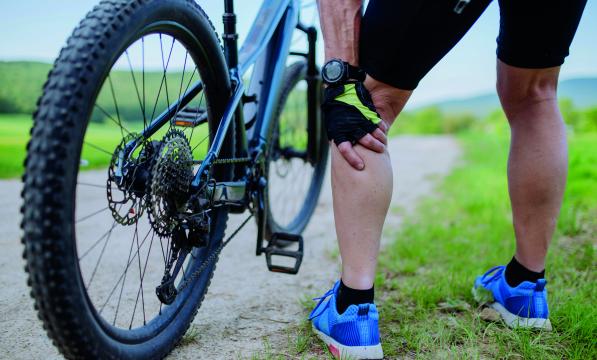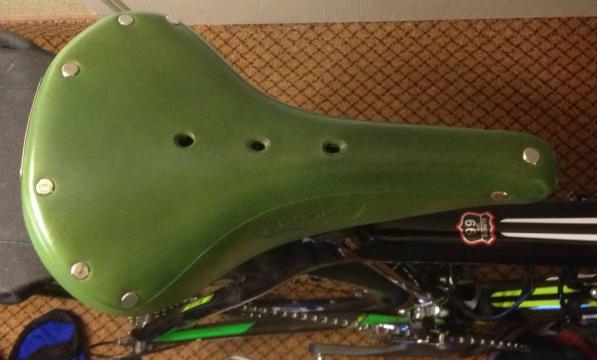Q&As: your health and cycling – illness and health conditions

What causes ringworm?
Q I have recently had ringworm on my legs. After several different treatments, it is at last beginning to fade. I am puzzled how I could have picked up this unpleasant condition. I do a lot of cycling on country lanes, while wearing shorts.
John Wenlock
A Ringworm (tinea) is a type of fungal skin infection. Despite the name, it has nothing to do with worms. Tinea corporis is the name given to the infection when it occurs on the trunk, legs or arms. A small area of infected skin tends to enlarge into a circular, inflamed, scaly and often itchy area. It can be a single ring-like rash or multiple patches.
Antifungal creams, such as clotrimazole and miconazole, usually work well and are available from pharmacies. An oral antifungal medicine is sometimes prescribed if the infection is extensive or severe.
The fungal spores can be spread from humans or animals (for instance, by stroking an infected dog or cat), or from infected objects such as towels, clothing and bedding. Rarely, they can be spread from lengthy exposure to infected soil. However, ringworm would not usually be caused by mud splashes while cycling and is not spread through animal faeces.
Anyone can get tinea, though it prefers warm humid conditions. For this reason, some forms may be associated with cycling. These are tinea affecting the groin (sometimes called jock itch or tinea cruris) and the feet (athlete’s foot or tinea pedis). Good hygiene and clean dry clothing and footwear should help prevent this.
Tinea can be similar in appearance to some other skin conditions and therefore if the rash fails to respond to treatment, other diagnoses should be considered.
Dr Matt Brooks
First published in the June/July 2013 edition of Cycle magazine.
Epstein Barr virus
Q Do you have any experience and understanding of the virus Epstein Barr? What advice would you give a regular cyclist on how to handle it?
Adrian Raynor
A Epstein Barr Virus (EBV) is a common virus that is a member of the herpes virus family. Spread through saliva, it is thought that as many as 95% of people in the UK will have been infected by the age of 40. Following exposure, there is an incubation period lasting several weeks before EBV causes an infection.
Most people are infected by EBV in childhood and experience very few symptoms. However, if the initial infection is delayed until adolescence, EBV can cause glandular fever with tiredness, fever, sore throat, swollen lymph nodes and an enlarged spleen. Glandular fever can last for several weeks.
Blood tests can detect antibodies against EBV to determine whether an infection is current, recent, or past. Many people who have had a mild form of EBV may not know they have been infected.
Treatment is largely supportive. Rest, treating the symptoms and, in cases of glandular fever, avoiding contact sports to reduce risk of rupture of the spleen are the basis of management. There are no anti-viral medications or vaccines available to speed healing or prevent infection.
For adult cyclists, the likelihood is you may have already had EBV. In mild or asymptomatic EBV infections, there may be little or no impact on fitness and performance, just as with any non-specific viral illness. However, in more severe cases, including glandular fever with significant fatigue, it may be necessary to have a significantly reduced training schedule or time off the bike. This is important as the body needs opportunity to recover.
Dr Matt Brooks
First published in the October/November 2014 issue of Cycle magazine.
Living with a hernia
Q I have the beginnings of a hernia. I’m told that provided I manage it properly it should not get any worse. Is there nothing that can be done to improve matters?
Tony Jones
A An inguinal hernia occurs when abdominal contents (including the lining of abdomen and sometimes bowel) protrude through a weakness in the abdominal wall. It can present as a lump or discomfort in the groin. The lump may appear when lifting or standing and disappear when you lie down. If there is doubt, an ultrasound can be performed.
Inguinal hernias occur mainly in older men though I’m not aware that it is any more common in cyclists than non-cyclists. Risk factors include obesity, constipation, chronic cough and heavy lifting, as they increase the pressure in the abdomen.
Irreducible hernias cannot be pushed back in. Strangulation is a medical emergency where the contents of the hernia become twisted or trapped by the narrow opening, cutting off the blood supply and obstructing the bowel.
Inguinal hernias can be repaired surgically, often as a day case, by pushing the hernia back into place and using a mesh to strengthen the weak point in the abdominal wall. A truss may be used when surgery is not possible.
I’ve heard it said that a recumbent bike is helpful as it encourages use of the thigh muscles rather than the abdominal ones, so won’t exacerbate the hernia.
Once it has started, I don’t think there are any specific exercises that can improve the hernia. It’s more a case of avoiding things that may exacerbate it such as heavy lifting. Saddle adjustment may help the pain but surgical repair is considered to be the definitive treatment.
Dr Matt Brooks
First published in the February/March 2014 issue of Cycle magazine.
Undercarriage cysts
Q Last spring I was diagnosed as having six benign epididymal cysts causing a swelling of the left side of my scrotum. While the cysts themselves do not trouble me I cannot sit symmetrically on the saddle, leading to strain in the lower back and soreness in the groin. My GP warns that surgery risks scarring and permanent pain, and the possibility of the return of the cysts. What are your thoughts?
Name and address supplied
A An epididymal cyst is a benign fluid-filled sac which forms in the epididymis (tubing which connects the testicle to the vas deferens/spermatic cord) behind each testicle. It is therefore separate from the testicle itself. Affected men may have one or several cysts on either or both testicles.
Small cysts are fairly common but rarely troublesome, so do not usually need any treatment. Larger ones can be several centimetres across and are more likely to cause discomfort. If necessary, these can be surgically removed.
The operation is a fairly simple one and recovery is usually uneventful. However, as your GP indicated, there are potential complications to be considered with any surgery. Although the risks are generally small, these include infection, bleeding, chronic pain and accidental damage to the epididymis or testicles. There is always the possibility of further cysts recurring after surgery.
While you should always go into any operation knowing the pros and cons, including chance of success and risk of complications, only you can really make the final decision whether to proceed. If the cysts really are having a significant detrimental impact, you should ask to see a urologist to decide whether surgery would be advisable.
Dr Matt Brooks
First published in the February/March 2015 issue of Cycle magazine.
A tick-ing bomb?
Q I have been unable to cycle for 18 months now and may never cycle again because of Lyme disease. This is a tick-borne disease and I most likely caught the tick while mountain biking across moorland or in woods. It might be worth warning members to take precautions. (I’ll never wear shorts again.) This disease seems to be on the increase and can have serious consequences.
Nicky King
A Lyme disease is a bacterial infection caused by Borrelia burgdorferi, transmitted to humans following a bite from an infected tick. It may cause a characteristic erythema migrans rash, flu-like symptoms including fatigue, and sometimes neurological, joint and cardiac issues. Prognosis is very good if treated early with appropriate antibiotics.
True incidence is unknown but estimated to be 1,000-3,000 people each year in the UK, with many cases being undiagnosed. In the UK, infection occurs in areas of woodland and heath including the New Forest, Exmoor, South Downs, Lake District and the Scottish Highlands.
In people with erythema migrans rash and a history of a recent tick bite or possible exposure to ticks, a clinical diagnosis of Lyme disease can be made without testing. In those without a rash, where the diagnosis is less certain, a blood test may be required.
The classic erythema migrans rash is a central red spot surrounded by clear skin that is ringed by an expanding red rash (like a bullseye) though this appearance can vary. It usually starts 7-10 days following the tick bite but can be anywhere from 3-33 days.
Minimise risk of tick bites by avoiding long grass and vegetation. If you can tolerate it, wear long sleeves and long trousers or tights tucked into socks. Light-coloured clothing can make it easier to identify ticks on your clothes. Consider using an insect repellent (some clothing is treated with this), inspect skin frequently, and remove any attached ticks as soon as possible, checking that ticks are not brought home on clothing.
To remove a tick, gently grip it close to the point of skin attachment using fine-toothed tweezers or a tick removal device, then pull slowly. Prophylactic antibiotics are not routinely needed following tick bite but seek medical advice if symptoms of Lyme disease develop.
Dr Matt Brooks
First published in the October/November 2016 issue of Cycle magazine.
Rash decision
Q I am a 56-year-old touring cyclist. Although I weigh 17 stone and have type 2 diabetes, I was cycling 40 miles each weekend. I have stopped riding due to worsening intertrigo. It was diagnosed years ago by a skin consultant who prescribed Timodine cream.
My current GP has stopped prescribing this. Apparently, the long-term use of steroids damages the skin. I wasn’t aware and have been applying Timodine liberally for years, as it is the only substance that relieves intertrigo.
My GP said he will only prescribe it if I sign a form stating that I accept its risks. Is there anything else I can do? I am waiting for an appointment to see a skin consultant.
John Osborne
A Intertrigo is a rash that affects skin folds, such as the groin and armpits, and is caused by a combination of friction, heat and moisture. It can affect anybody but is more common in people who are overweight, those with diabetes, and those who have a tendency to sweat more.
The rash is usually inflamed and often involves a fungal or bacterial skin infection. If it is recurrent or not responding to initial treatment, a doctor may take a swab or skin scraping to identify any infection.
Treatment usually involves an antifungal and/or antibiotic (either as cream or tablet), and a mild steroid cream for relieving the inflammation and itching. Timodine is one of several combination creams commonly used for short periods to treat intertrigo. Timodine contains a mild steroid (0.5% hydrocortisone), antifungal, antiseptic and barrier component.
Intermittent use of mild steroid creams is usually safe if applied thinly for short periods (a week is often enough for less severe cases), although prolonged use and more potent steroid creams are best avoided due to the risk of them causing skin thinning and ulceration.
The likelihood of further episodes may be reduced by addressing any underlying cause or risk factors. So, in your case, losing weight as you are trying to do is a good idea. Good control of your diabetes should also help.
Try to keep affected areas clean and dry; if necessary, you could use standard talcum powder. Cycle clothing that takes the moisture away from your body, followed by a shower after a ride, should go some way to helping.
Dr Matt Brooks
First published in the April/May 2016 issue of Cycle magazine.
Diabetes and energy drinks
Q I’ve just had my annual blood tests done. The result was a slight impairment of glucose regulation. This did not show diabetes but could increase the risk in the future. This got me thinking about the energy drink I use (SIS Go Energy). Is this OK or should I consider changing? I don’t go hard and fast on my rides, generally a steady 50 miles at around 12.5mph.
Alan H Tyler
A Diabetes is a relatively common condition that results in raised blood sugar levels. Type 2 diabetes, which usually develops later in adulthood, is far more common than type 1 (which often appears in childhood).
Many people have blood sugar levels above the ‘normal’ range, but not high enough to be classified as diabetes. Several terms may be used for this by doctors. These include ‘impaired fasting glycaemia’, ‘impaired glucose tolerance’ and ‘pre-diabetes’. These people are more likely to go on to develop diabetes over time. However, this risk can be reduced by eating a healthy diet, maintaining a sensible weight, and taking regular exercise.
Overall diet and lifestyle are more important than individual food items or drinks. A diet which is high in fruit and vegetables and lower in sugars, fat and salt is (as usual) best. It is generally recommended to eat some starchy carbohydrates at each meal, such as pasta, rice and grainy breads, as these release energy over a more prolonged period.
In terms of what to drink during and after cycling, water is perfectly adequate, especially for shorter rides. If you are cycling for more than an hour and would prefer to take a ‘sports drink’, you could save some money by making your own using cordial, water and a pinch of salt. There’s no need to use any particular brand.
Dr Matt Brooks
First published in the February/March 2016 issue of Cycle magazine.
Escaping labyrinthitis
Q I had labyrinthitis recently, causing nausea and balance problems. Is it cycling related? How can I avoid it?
Stewart Nicholl
A The inner ear (labyrinth) consists of a system of fluid-filled tubes. These include the cochlea, which is concerned with hearing, and the vestibule and semi-circular canals, which act like a spirit level, sensing head movements and assisting balance.
Labyrinthitis is inflammation of the inner ear, often due to an infection. Many cases are thought to be viral and some will be preceded by a common cold. It causes vertigo (dizziness with a spinning sensation) and this may be severe, often with vomiting. Temporary hearing loss and tinnitus (ringing or buzzing in the ear) may also be present. Labyrinthitis usually resolves spontaneously within a few weeks.
Although not caused by cycling, labyrinthitis may prevent you from being able to ride until you recover. There is no way to avoid it but, if severe, sometimes a course of anti-sickness tablets (such as prochlorperazine), or an antihistamine (such as cinnarizine) may be prescribed to ease the symptoms. No investigation or treatment is required in most cases. A full recovery is usual in a few weeks.
Other conditions can cause similar symptoms. These include BPPV (benign positional paroxysmal vertigo), which causes vertigo on specific head movements or positional changes. See your doctor if you have prolonged or recurrent symptoms, or if the diagnosis is uncertain.
Dr Matt Brooks









